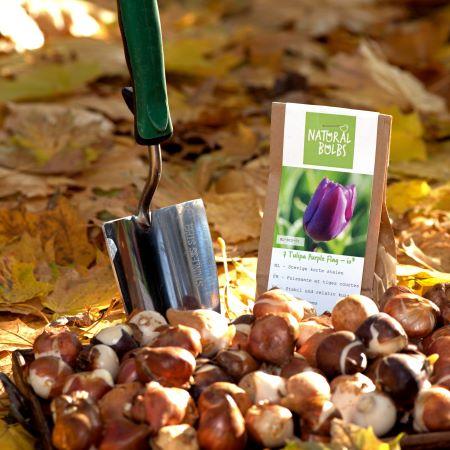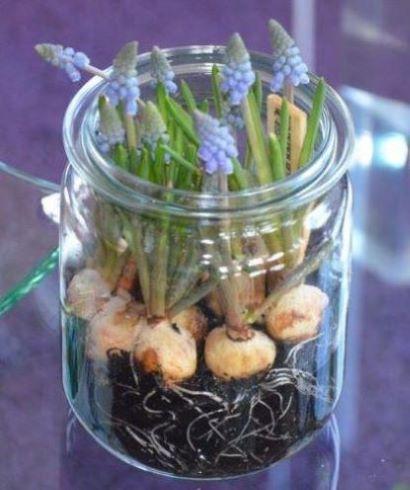Planting flower bulbs
There are a number of different periods to plant bulbs and tubers. This is because there is no real exact date to plant them. However, there are two periods of several months in the year when it is best to put the bulbs or tubers in the ground.
Tulips, crocuses and other spring bloomers can be planted in autumn (Sep-Dec). Even if there is night frost in December, you can still plant them. In the meantime, the bulbs will make roots under the ground and then stay quiet until spring. Rule of thumb - plant 4 weeks before the soil starts to freeze.
Depending on their hardiness, summer bloomers can be potted indoors or planted directly outside. The advantage of starting indoors is that the plants often flower a month earlier. Soft summer flowers such as dahlias are best started indoors from March and planted out in May.
Click here for Dahlia planting instructions.
 When is the best time to plant bulbs & dahlias
When is the best time to plant bulbs & dahlias
Spring-flowering bulbs, think crocuses, tulips, daffodils and the blue grape, are the first flowers you see, signalling that spring is almost here. These spring-flowering bulbs are planted between September and December. Early-flowering spring bloomers such as the crocus may go into the ground earlier, as late September-early October. Rule of thumb - plant 4 weeks before the ground starts to freeze.
Plant the bulbs as soon as you receive them. Make sure the temperature at night is below 10 degrees Celsius. If the temperature is higher or you don't have time, put the bulbs in a dark, dry and cool place (no warmer than 15 degrees). Anemone, Erythronium, Fritillaria Meleagris, Fritillaria uva-vulpis, Leucojum Vernum and Ipheion Uniflorum are bulbs that dry out quickly and are therefore better stored in sand or peat moss.
It is also important to get the bulbs into the ground before frost. Never plant the bulbs on a day when it rains very hard or when it freezes. The chance of the bulbs rotting or freezing as a result is then quite high and that would be a shame. Plant the bulbs in a place where they will get sun and, for later-flowering bulbs, take into account the leaves of the trees that will come up in spring.
If you have a certain spot in the garden where there is always a puddle of water? Do not plant bulbs here, because they do not like their roots to be too wet. This can cause the roots to mould or rot.
How do I plant my bulbs?
When planting the bulbs, it helps to loosen the soil a little. You could also try to improve the soil a bit.
Click here for more information on the right conditions of the garden.
Dig a hole 2 to 3 times as deep as the height of the bulb. The distance between the bulbs is 3x the width of the bulb, for large bulbs (12/+ cm) and small bulbs (5-7 cm).
Put the bulbs in the soil with the pointed side up, cover with soil and water the bulbs when dry. Now just wait for a flowery spring.
How many bulbs per m² do I need?
For spring flowering bulbs:
General rule of thumb: 20 bulbs per m².
Small bulbs: 50 to 200 bulbs per m².
Large bulbs: 15 to 25 bulbs per m² (or as an accent between perennials - 5 bulbs per m²).
Plant naturalising bulbs with a bit more space so they have room to expand.
For summer flowering bulbs:
Dahlias about 3 to 5 per m².
Making spring bloomers flower at home
Many bulb varieties can be flowered early in the living room. This is called forcing and you do it as follows:
- Plant a few bulbs in a pot and put them in a cool place (around 5-9 °C, e.g. a cellar or your fridge). They don't have to be kept in the dark, but it's okay if you do. Leaves will appear first. However, wait patiently until you can feel the flower bud as a thicker lump between the leaves.
- Only then may the flower pot go into the living room and you can be sure that the flowers will bloom inside.
- On average, the cooling period lasts about 10 weeks. So if you want flowering plants at Christmas, you should definitely start planting them as early as the beginning of September.
- It is also possible to plant flower bulbs not in soil, but in a glass with water to bring them into bloom. Especially with hyacinths, this is often done. Hyacinths can also be kept slightly cooler, around 12°C. The hyacinths can then enter the living room at 8 weeks.
What can you do with premature bulbs?
The warm climate doesn't work so well for bulbs that have gone into the ground early or are still in there from last season. Most bulbs can take a little frost. The emerged plant will probably not survive the frost, that will most likely show in spring. The plants will look less vital than if they had not suffered from the mild winter. This is because the plant has to rely on the private supply of nutrients contained in the bulb to come up. If the plant comes up twice in a short time, the stock will be a lot lower the second time.
Make sure the plants stay clear of leaves so they don't suffocate and rot. You can sprinkle some lime around them to ensure that fungi have little chance of getting to the plant. If the plants have already grown reasonably well, it is best to cover them during frost, so they have less chance of rotting and dying. The bulb in the ground still has enough reserves for the plant to grow strongly in spring.
Read here to know what to do with flowers after they have bloomed.








